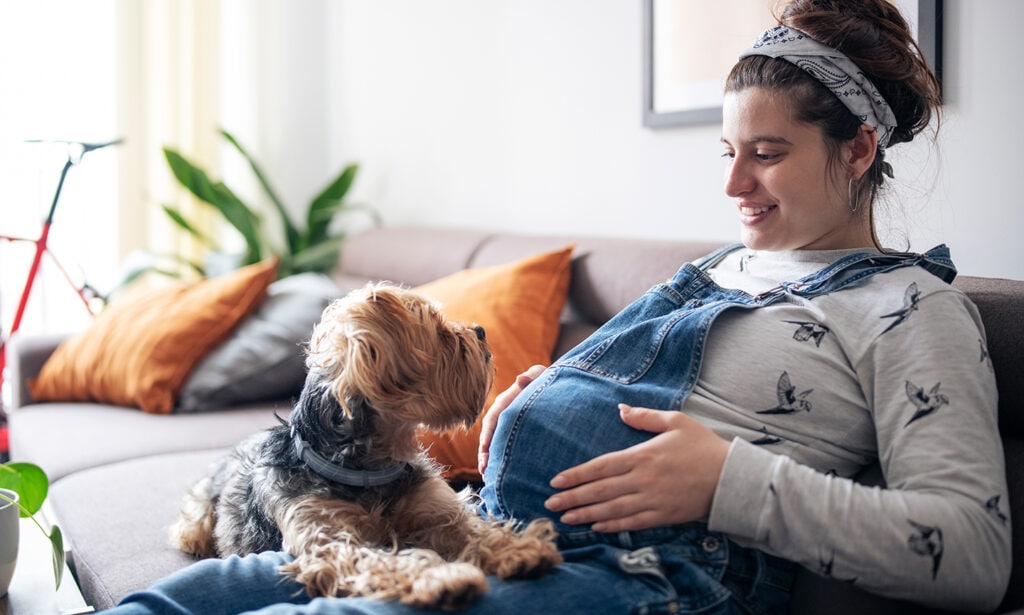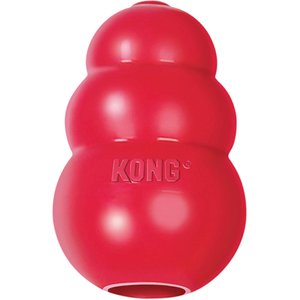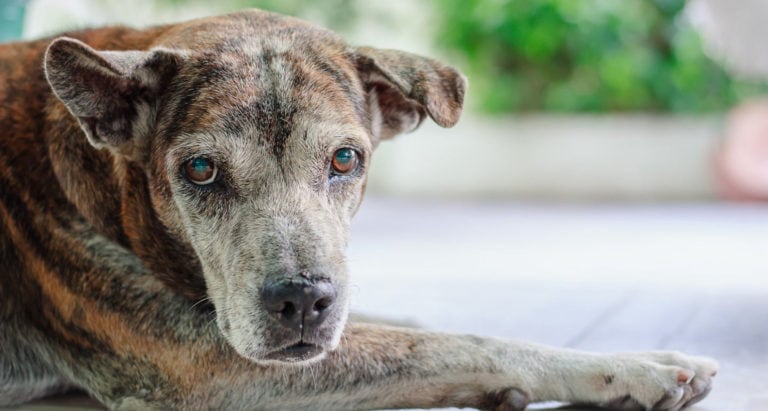Envisioning a cuddlefest between your furbaby and newborn baby is dreamy, but in reality, it’s not safe. Dogs with newborns are unpredictable, and rushing an interaction creates more anxiety for even the most family-friendly dog and parents, who are trying to adapt to a new lifestyle with loud sounds, pungent smells, hormonal fluctuations—and very limited sleep.
That doesn’t mean your babies won’t be rock-solid cuddle buddies, long-term. The first step to a successful child-dog relationship is preparing your dog far in advance for the baby’s arrival. Don’t know where to start? Our experts walk you through how to prep your pup and maintain safe and positive interactions during those first few months of parenting.
Can Newborns Be Around Dogs?
New babies and dogs can be in the same room with absolute, fully attentive supervision of both baby and dog (think: dog on a loose leash or an adult standing between dog and newborn), but close contact is not recommended.
“We have to remember…newborns are very fragile,” says Certified Dog Behavior Consultant Jennifer Shryock, B.A., CDBC, founder of Family Paws, which hosts educational webinars and private consultations worldwide to help expecting and new parents with pets adapt to life with babies and young children.
A dog doesn’t view a baby as a new family member, but rather a curious, unusual change in the house. “There’s no need for a dog to be up close and personal with a baby,” says Shryock. In fact, keeping the dog and newborn separated helps establish boundaries for the dog, and our experts agree, will not ruin any future bonding between the two.
How do we set those boundaries? Regardless of the dog breed or size, start training and prepping your pup early. Establishing a new normal for Fido gives you tools to manage stressful—and potentially dangerous—situations.
How to Prepare Your Dog for a Newborn
There’s no such thing as too early when it comes to preparing your dog for sharing their turf and your undivided attention with a newborn baby.
“Dogs do like routine and consistency,” says Dr. Ana Clara Muñoz, DVM, a behavioral veterinarian with the San Francisco SPCA Behavior Speciality Service in San Francisco, California. “When that changes, it is a little hard on them when they aren’t expecting it.”
Don’t wait until the due date. Work with your dog as soon as the pregnancy test is positive. Even better, while you’re trying to get pregnant, address any behavior concerns, such as leash reactivity;fear of people, children or other animals; or separation anxiety, explains Dr. Muñoz.
Follow these tips from Dr. Muñoz and Dr. Wayne Hunthausen, DVM, director of Westwood Animal Hospital’s Animal Behavior Consultations in Westwood, Kansas, to get your dog ready before bringing the new baby home:
Designate Safe, Contained Spaces for Your Dog
Place dog gates, playpens and dog crates in your home and form positive associations with these spaces with abundant treats, toys and praise, says Dr. Hunthausen. These safe spaces serve dual purposes:
- They ensure safety when one parent is with the baby and needs to control a situation quickly.
- They give your dog the option to have alone, calm time if they start to get anxious or stressed.
Read more about deciding between a dog pen or dog crate.
Teach Your Dog Basic Training Cues
Review these five training cues before bringing baby home:
- Sit
- Stay
- Down (no jumping on the person holding the baby)
- Go (especially helpful when cueing your dog to go to their safe space
- Leave it (pacifiers, bottles, baby blankets, breastfeeding equipment, baby toys and diapers are not dog toys!)
If needed, hire a certified dog trainer to ensure your pup can perform these tasks with confidence.
Learn Your Dog’s Body Language
Before dogs show the obvious signs of fear (growling, biting, lunging), dogs communicate using more subtle body language showing that they’re stressed and fearful. These signs give insight into how your dog feels about their time with the baby. If you notice any of the following, practice cueing your dog to go to their safe spot:
- Trembling/shaking or hesitating
- Tail tucked
- Whale eyes
- Panting
- Yawning
- Licking lips
- Ears back
Establish Boundaries
Teach your dog what’s off limits. If your dog won’t be allowed on the couch, or other areas where parent and baby spend much of their time, implement those new rules as soon as possible. Create a new sleeping area away from your bedroom, or section off a part of your home and use positive reinforcement through treats and praise to get your dog used to their new set up.
Enlist Trusted Helpers
A new baby takes up time once dedicated to your furry friend’s physical and mental engagement. Find ways to maintain your dog’s activity levels by asking a family member, friend or hiring a dog walker to take your pup for walks during the day or trips to the dog park, says Dr. Muñoz. Start this process months before the baby is born so your dog gets used to this person and the new routine.
Introduce Common Baby Sounds, Smells and Equipment
Desensitize your dog to sharing a space with a variety of baby items. Here’s a start:
- Emulate carrying a baby by filling a pillowcase with water bottles, which carry weight like a baby, while interacting with your dog.
- Take your dog for walks with the stroller, so they get used to walking next to that large object.
- Expose your dog to the sound of a baby crying
- Set up the nursery, particularly if the nursery is replacing a room in which your family dog likes to spend time.
- Socialize your dog to the sounds of children and practice following cues in areas with distractions.
Stock Up on Mental Engagement Tools
There’ll be some days where you or your helpers can’t manage two dog walks a day or even a game of fetch. Have lots of options ready to engage your dog with teeth-safe chew toys, like a Kong, filled with treats or soft foods. Food puzzles, snuffle mats filled with treats or kibble and lick mats coated in dog-safe peanut butter or wet dog food engage your dog by keeping them mentally stimulated, says Dr. Hunthausen.
Try these products that’ll keep your dog happily engaged:
Introducing a Newborn to a Dog
Shryock encourages parents to change their mindset of the word “introduction,” which puts too much emphasis on the first meeting. Instead, she extends the dog and baby interaction to a three-month stretch she calls the homecoming period, where the dog is getting used to a new being in their former turf and deciding how to feel about this new addition to their home.
Think of each dog and newborn encounter as an opportunity for a positive interaction.
Here are six ways to encourage positive association when it comes to dogs with newborns:
1.Give Treats Freely
Each time the dog sees, smells, hears or interacts with the baby, give them a treat. Reinforce that the baby is a positive, good new addition to the home and not a threat. “If your dog walks in and sees the baby, praise and treat before they have any thoughts or concerns," says Dr. Hunthausen. “You want to pour on the praise.”
To create space and move your dog away from the baby—for example, if the baby is crying or the dog is barking—toss treats to another part of the room, adds Dr. Muñoz.
2. Don’t Punish Your Dog For Their Initial Reactions
Scolding your dog for shying away, acting fearful, territorial or jumping around the baby often creates more anxiety and teaches the dog to fear the baby. Punishment displaces and can worsen the behavior. Remember, your dog counts on you to show them the new baby is a positive presence in the household!
3. Use a Harness and Loose Leash
Because you’ve been practicing walking your dog on a leash in the house, while you’re carrying your pillowcase of water bottles, it’s part of the new normal for your pup and is a reassuring safety barrier for those first handful of greetings.
For an extra layer of protection, train your dog to wear a basket muzzle around the baby, says Dr. Muñoz.
4. Make Baby Time, Fun Time
Aside from treating and praising your dog for positive interactions with the baby, have one adult play recall games with the dog while another another sits with the baby across the room on the couch. Cue the dog to sit for a treat. Then toss a toy across the room and repeat.
5. Strategically Plan Your Dog’s Enrichment Activities
During the baby’s feeding time, when your undivided attention is on the newborn, bring out a food puzzle or lick mat to occupy your dog. They’ll start to associate that the baby’s feeding time is a fun time for them, too.
6. Implement Short and Sweet Interactions
If your dog seems curious (and is properly trained on their basic-training cues) about the baby’s scent, wrap your newborn in their blanket and extend it at least 12 inches from the baby’s feet. With active supervision, leash your dog and let them sniff the baby from a safe distance, suggests Dr. Hunthausen. End on a positive note (treats, praise, playtime) after the brief interaction.
Other Dog and Infant Safety Tips
Even with all the prep, there is still a level of unpredictability when emotions, expectations and hours of sleep are fluctuating.
Implementing these safety tips gives your household precaution against physically dangerous scenarios:
Provide ample contained areas for your dog, both for daytime and night. Remember, if you put the prep work in, these are not negative spaces, but rather a safe space for your dog to feel at ease. Alternatively, surround yourself with an 8-panel playpen when holding the baby, suggests Shryock.
Wear the baby in a baby carrier around the house. This requires full, awake supervision and leaves the parent or guardian’s hands free.
Go slowly. “You don’t want a lot of really sudden changes,” says Dr. Hunthausen about introducing new sounds, smells and rules, which naturally throws off the dog and can lead to anxiety and unpredictable behavior.
Dogs shouldn’t be unsupervised in the same room as newborns. There should always be direct, active supervision, even if the dog is 100% predictable in their obedience cues and socialization.
Keep security measures in place for when the baby starts crawling and grabbing, even if your dog seems to be adjusting well to the newborn stage. In general, do not have the baby approach the dog first, which can feel unpredictable and cause the dog to react negatively.
Don’t panic if your dog is slow to warm up to the new baby—that’s normal and not indicative of their future relationship. Continue socialization and if your pup is still showing stress signs after a couple months, contact your veterinarian or behaviorist for advice.
Looking for more helpful information to prepare your dog for baby? Learn to read your dog’s body language to prevent issues before they happen.
Share:















